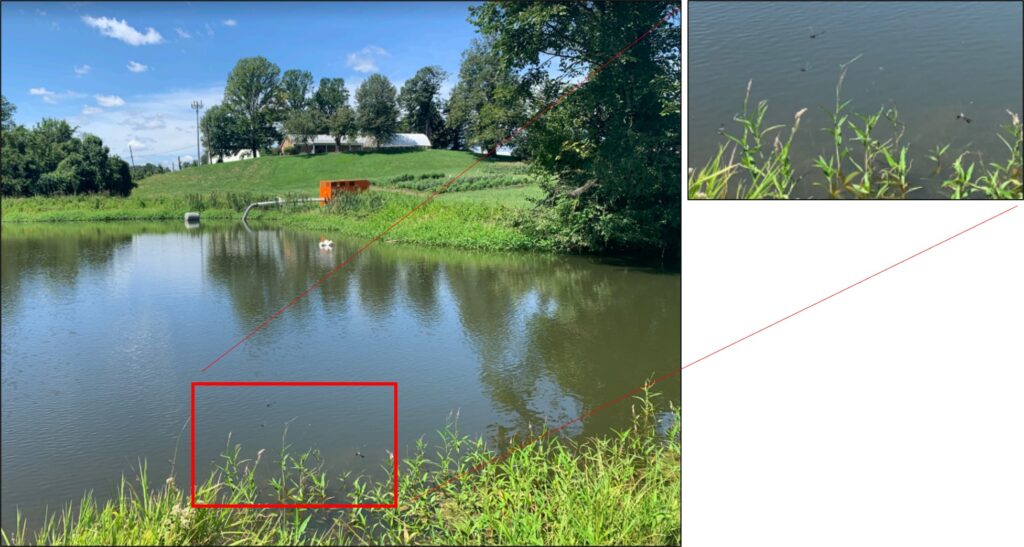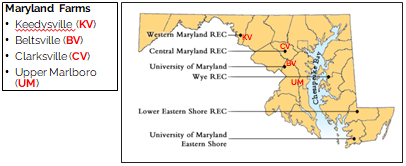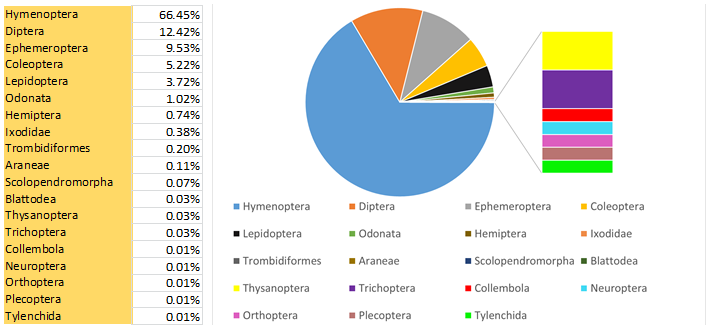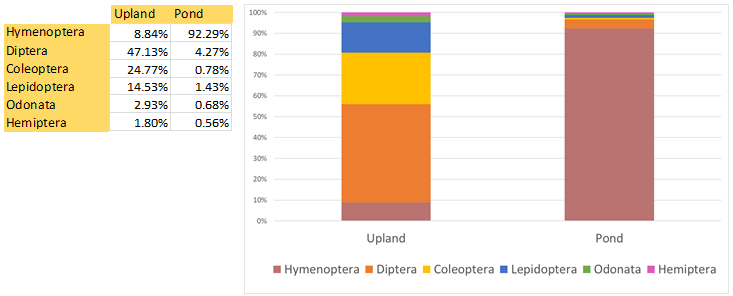Final report for GNE21-257
Project Information
Dragonflies and damselflies (Order Odonata) are opportunistic predators as adults. However, the potential for adult dragonflies as biological control agents in agroecosystems has been understudied, in part because their presence and diet on farms is not well understood. Surveys were conducted on four Maryland farms to assess the richness and abundance of dragonfly and damselfly species during the growing season of 2021 (June through September). Fecal samples were collected from 13 different dragonfly species at three Maryland farms to determine their diet using next generation sequencing (NGS) through the genomics company GENEWIZ using their Amplicon-EZ service. We surveyed a total of 20 dragonfly and 6 damselfly species across four farms. Most odonates on farms are cosmopolitan species with robust bodies and a dependence on lentic water sources. Average abundance varied across farms from less than one dragonfly surveyed per day at the least abundant farm to 36 at the most abundant farm. The farm with the highest abundance also exhibited the greatest species richness with 22 of the 26 species surveyed. Preliminary findings suggest a healthy and well established on-farm water body could be supplying breeding habitat for dragonflies and damselflies at the most specious and abundant farm. Sequencing results detected a total of 19 arthropod orders present in fecal samples from 94 individual dragonflies. Insects in the orders Hymenoptera and Diptera were the most abundant source of DNA in the fecal material making up around 66% and 12% of the total diet respectively. Advances in molecular techniques can further our understanding of dragonfly and damselfly diet in the future. Subsequent research on the health and habitability of on-farm water bodies used for drainage retention and waste containment can help farmers understand the importance of these water bodies for environmental and economic benefits.
The overall goal of this study is to better understand dragonfly and damselfly community composition, prey selection and their potential for pest suppression in agroecosystems. This goal can be divided into two research objectives:
- To compare richness and abundance of assemblages of adult species of dragonflies and damselflies among farms and crops.
- To compare prey composition using next generation sequencing (NGS) of feces from multiple dragonfly species between upland farm habitat and near water habitat.
The purpose of this project is to determine whether dragonflies and damselflies (Odonata) eat insects that are pests of agricultural crops. Odonates provide humans with ecosystem services in several ways, with one primary contribution being their ability to eat large quantities of arthropods often considered pest species. It is well understood that adult dragonflies are generalist and opportunistic insectivorous predators. Dragonfly and damselfly diet analyses consistently show small Diptera as primary prey, but they are known to eat a wide range of insects. Most prey capture occurs in flight, but damselflies and one family of dragonflies can glean prey from surfaces (Corbet 1999), which broadens the range of potential prey species. Historic diet studies consist of field observations and gut content identification. Both of these techniques are problematic due to observer bias and labor intensive, time-consuming methods. New molecular technology using fecal metabarcoding can provide a more complete analysis of predator diet. This rapid and comprehensive methodology for analysis of dragonfly diet can help future researchers understand the importance of dragonflies and damselflies as ecosystem service providers in both agricultural and urban habitats.
Chemical insecticides, though widely used, pose several challenges to farmers. They can be costly, incite concern from the public regarding safety, and induce insect resistance leading to pest outbreaks. Predatory insects used as biological control in agriculture are an alternative to chemical pesticides and can indirectly improve soil and water quality by reducing chemical inputs into the environment. Dragonflies are good candidates for conservation biological control in agroecosystems. Oftentimes, farmers augment water flow in their fields and, when necessary, retain water for later irrigation in on-farm retention ponds. These water sources can be areas of high adult dragonfly activity and possible breeding and oviposition habitat for subsequent generations of dragonflies. The theory of conservation biological control is to improve survival, fecundity, longevity, and behavior of a natural enemy through such activities as reduction of pesticide use and habitat enhancement (Holland et al. 2016; Landis et al. 2000). By showing the importance of dragonflies as natural enemies of agricultural pests, we can then begin to help farmers create conservation biological control plans inclusive of dragonflies on farms, as well as outline actions for improving the quality of on-farm water bodies.
Research
Objective 1: To compare richness and abundance of assemblages of adult species of dragonflies and damselflies among farms and crops.
Quantifying dragonfly and damselfly richness and abundance in agroecosystems will help farmers and researchers better understand the specific species assemblage associated with farmlands. To date, no research has focused on precisely which dragonfly species are utilizing farmland as foraging habitat. To address this objective, visual encounter surveys (VES) were conducted in multiple crop fields and water bodies at different farms to assess whether different dragonfly communities occur across agroecosystems. The four University of Maryland farms used for this study were in central and western Maryland and included the Western Maryland Research and Education Center in Keedysville (KV), and three Central Maryland Research and Education Center locations in Beltsville (BV), Clarksville (CV), and Upper Marlboro (UM). Timed VES were conducted in three crops at each farm and a water body at CV and UM. Clakrsville and Upper Marlboro were selected for water body surveys because they had large, well-established on-farm water retention ponds and livestock waste lagoons. Alfalfa, soy and corn were used because they are important cash crops throughout the eastern United States and dragonflies have historically been observed as predators of pests in soybean. Twice a month from June 2021 through September 2021, 30-minute VES were conducted at each farm in crop fields and water bodies twice a day, once in the morning and once in the afternoon. These surveys were conducted over several days, with one farm being visited per day. Each VES field was approximately 60 m x 60 m. During the VES, the number of novel dragonfly and damselfly encounters were recorded as well as identified to species whenever possible. Most dragonflies were easily identified to species using binoculars; However, when necessary, individuals were collected and photographed for later identification. Crop height, cloud cover, temperature, wind speed, time, behavior at time of sighting, sex, and, if applicable, maturity of dragonflies were also recorded. The behavior of the dragonfly was described as flying, perching, foraging, aggression or tandem flying. A one-way ANOVA was performed to determine differences in dragonfly species abundance among farms.
Fig 1. University of Maryland farms used for this study include Keedysville (KV), Beltsville (BV), Clarksville (CV) and Upper Marlboro (UM).
Objective 2: To compare prey composition using next generation sequencing (NGS) of feces from multiple dragonfly species between upland farm habitat and near water habitat.
To answer this objective, dragonfly individuals of multiple species and both sexes were collected once a month at three University of Maryland farms, CV, UM and BV (Fig. 1). Dragonfly fecal samples were collected both in the upland crop fields at CV, UM and BV as well as at an on-farm water body at UM, because many dragonflies exhibit differential foraging in upland versus near water habitats. Fecal sampling was performed at the farm level, not the crop level, to ensure the collection of a large enough sample size. Sampling was not timed but rather at least ten individuals were collected per month at each farm for a minimum monthly total of five dragonflies from upland crop fields and five from on-farm water bodies. Dragonflies were captured using an aerial net and transported back to the lab for 24-hour fecal sampling. To sample feces, the dragonfly was placed in a sterile 50 mL Eppendorf tube for 24 hours during which time they defecate membrane bound pellets in the tube. Sterile micropipette tips were used to remove feces every three hours to a sterile microcentrifuge tube and placed on ice in the field or freezer in the lab (Fig. 2). Feces were processed in a molecular genetics lab at the University of Maryland using the Qiagen DNeasy Blood and Tissue Kit for DNA extraction. After DNA extraction, polymerase chain reaction (PCR) was conducted to amplify the DNA (Fig. 3). The target region was the cytochrome c oxidase subunit I mitochondrial gene (COI) using universal primers. During PCR, the DNA sample was mixed with PCR PreMix, primers and ddH2O and incubated in the thermocycler at 96˚C for 3 minutes followed by 35 cycles of 94˚C for 30 seconds, 50˚C for 30 seconds and 72˚C for 45 seconds. Lastly, the sample was incubated at 72˚C for 10 minutes. PCR products were purified using the ExoSAP-IT Express reagent in preparation for next generation sequencing (NGS) by the genomics company GENEWIZ using their Amplicon-EZ NGS service. During PCR cleanup, the post-PCR reaction product was mixed with ExoSAP-IT Express and incubated in a thermocycler at 37˚C for 4 minutes followed by incubation at 80˚C for 1 minute. NGS will give a broader profile of the prey DNA in the feces compared to Sanger sequencing. GENEWIZ provides clients with DNA sequences as well as gel electrophoresis images. Sequences provided by GENEWIZ are currently being compared to the NCBI GenBank database to determine the proportion of the diet composed of agricultural pests.
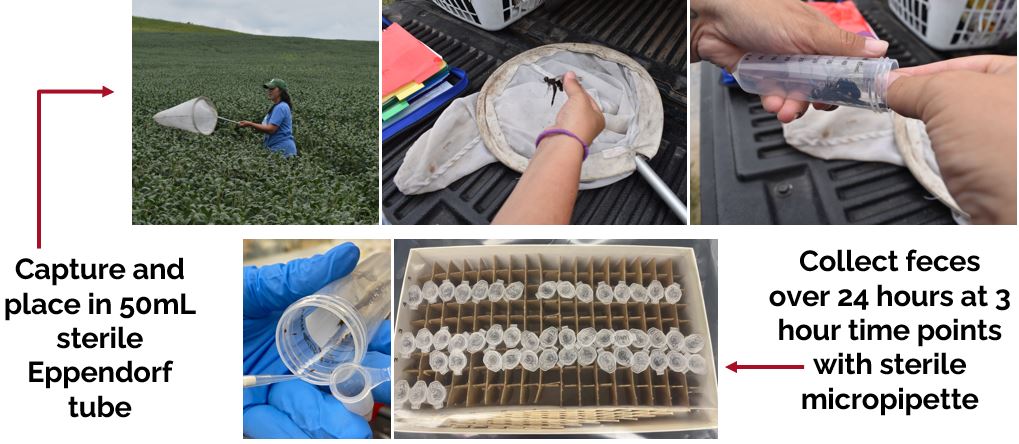
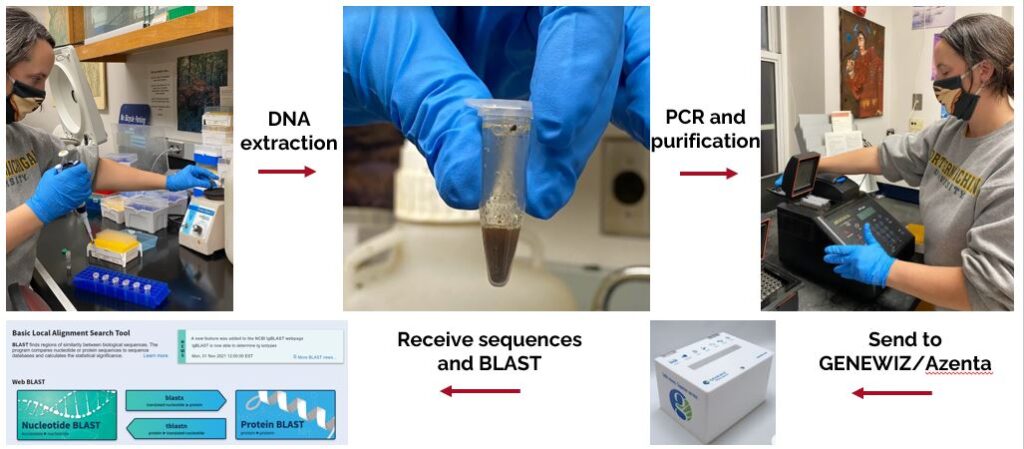
Objective 1
A total of 26 species in six families of dragonflies and damselflies were surveyed across all farms, seven at Keedysville, 17 at Beltsville, 15 at Clarksville, and 22 at Upper Marlboro (Table 1; Fig. 4). Of the total 26 odonates, 20 were dragonflies and 6 were damselflies. The five most abundant species were in the family Libellulidae and included the common whitetail (Plathemis lydia), widow skimmer (Libellula luctuosa), blue dasher (Pachydiplax longipennis), Eastern pondhawk (Erythemis simplicicollis), and Eastern amberwing (Perithemis tenera). The habitat preferences of the most abundantly surveyed species are similar. They are common, cosmopolitan species found in all counties in Maryland and they are associated with slow-moving, lentic water bodies (Maryland Biodiversity Project 2021). Average daily abundance at Upper Marlboro (36 ± 49) was significantly greater than at Keedysville (0.4 ± 0.6), Beltsville (6 ± 5), and Clarksville (7 ± 9) (ANOVA, p < 0.001).
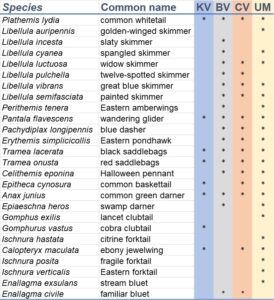
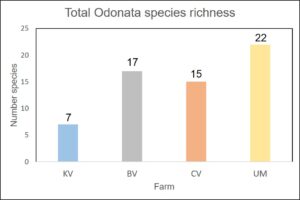
Objective 2
A total of 97 dragonflies were sampled for fecal material across 13 species at three farms. During a 24-hour period, dragonflies produced an average of 20 fecal pellets, with a minimum of 1 and maximum of 53. Most of the fecal material was sampled during the first 12 hours post capture.
Of the 97 dragonflies sampled, 94 samples were sent to GENEWIZ for next generation sequencing using their Amplicon-EZ service. Libraries containing unique sequences were produced for each individual dragonfly. NCBI BLAST was used to extract corresponding species matches to all nucleotide sequences greater than 100 base pairs. Matches were only recorded if the percentage similarity was greater than 90%.
Results were pooled for all individual dragonflies to gain a broad understanding of their diet. Overall, the fecal material contained mostly Hymenoptera (66.45%), with a total of 19 orders of arthropods (Fig. 5).
Fig 5. Pooled results of fecal content from 94 individual dragonflies. Sequences were analyzed using NCBI BLAST. Percentages are derived from counts of unique sequences given by the company GENEWIZ using NGS Amplicon-EZ sequencing.
Broad comparisons were made between fecal material collected from dragonflies in the upland crop habitats and those near ponds at one farm, Upper Marlboro (Fig. 6). The most prevalent arthropod prey included Hymenoptera, Diptera, Coleoptera, Lepidoptera and Odonata. Ephemeroptera was excluded from this analysis because it was only present in one fecal sample.
Fig 6. Pooled fecal samples from 68 upland dragonflies and 26 pond dragonflies show the primary prey differs by habitat. Upland dragonflies fecal material contained primarily true fly (Order Diptera) and pond dragonflies contained primarily wasps, bees and ants (Order Diptera). Percentages are derived from counts of unique sequences given by the company GENEWIZ using NGS Amplicon-EZ sequencing.
Dragonflies are not used in classical biological control for various reason, one being that they are highly mobile and most species can easily disperse beyond the farm to find better foraging and breeding habitats. However, their presence and role in agroecosystems is not well understood. Our findings show both the presence of dragonflies and damselflies throughout the growing season on farms as well as a preliminary glimpse at their diet.
Most of the species of odonates on the four Maryland farms surveyed were dragonflies (20 of 26). Furthermore, 15 of the 26 species were in the family Libellulidae, which are primarily lentic water dependent species. Maryland has a total of 183 surveyed species of dragonflies and damselflies, and our surveys show around 14% of those species are found on farms. These preliminary surveys reveal a predominance of large bodied dragonflies that may not only be using the farms for foraging habitat but also for breeding habitat. Two of the four farms surveyed had on-farm lentic water bodies that may be supplying the farm with adult dragonfly predators in the upland crop areas. The farm with the highest odonate abundance had a well vegetated retention pond with an abundant community of adult odonates. Further research across different agroecosystems and farming techniques (organic versus non-organic) must be conducted to make more conclusive predictions about the community composition of odonates on farms.
The fecal material of dragonflies on farms shows a variety of arthropods present in their diet. There is a clear preference for Diptera and Hymenoptera across farms and habitats within farms, which is corroborated by previous research conducted outside agroecosystems. However, we cannot say based on our research if they are eating more individuals of any particular athropod. For instance, many small true flies could equal one large wasp. Additionally, large bodied dragonflies are strong fliers and can easily leave the farm to forage elsewhere for urban or woodland prey. Their role as biological control in agroecosystems is still unknown, but advances in genomic methods and sampling techniques can reveal connections between their diet and farm pests.
Education & Outreach Activities and Participation Summary
Participation Summary:
Providing farmers with information about dragonflies and damselflies as beneficial predators is a priority for this project. Many people believe dragonflies are primary predators of mosquitoes, though there is little scientific research confirming their diet composition. It is therefore important that more empirical data, rather than conjecture, about dragonflies be included in extension articles and presentations. Since there is limited peer-reviewed literature about dragonflies in agriculture, it is vital to release our findings to other scientists and researchers through presentations at professional meetings and publications. This is an important first step in generating interest in continued research on dragonflies in agroecosystems.
We plan to communicate the importance of dragonflies as predators for biological control with stakeholders in Maryland and throughout the region in several ways. Presentations at the National and Eastern Branch Entomological Society of America, Society for Freshwater Science and Dragonfly Society of the Americas meetings through both poster and oral presentations are planned for 2023. A main outlet for local outreach to farmers will be through publications, meetings and workshops hosted by the Maryland Organic Food and Farming Association and University of Maryland Extension. Publishing pamphlets and fact sheets in both local agricultural publications, such as Agronomy News, and on the University of Maryland Home and Garden Information Center website, as well as preparing manuscripts for peer-reviewed journals will be prioritized. My personal interest and passion for dragonflies will ensure I continue to discuss their importance through outreach and extension well beyond my projected graduation date.
Project Outcomes
My project will contribute to future sustainability by informing farmers and other agricultural stakeholders of the value of dragonflies as predators in agroecosystems. This project is one step in helping farmers understand odonates and their biological control function on their farms. Additionally, farmers can begin to appreciate the ecosystem services on-farm water bodies, such as retention ponds and livestock lagoons, provide. Small changes in practices that increase the health of these water bodies can also increase economic and environmental benefits to the farmers. In the next year, I will present my findings at several meetings such as the Eastern Branch Entomological Society of America and the Dragonfly Society of the Americas, as well as find opportunities to educate Maryland farmers at the local level.
Throughout the course of this project, my advisor and I have gained knowledge about the prevalence and community composition of odonates on farms. Farmers are aware and know there are dragonflies and damselflies on farms, but knowledge is lacking on how to encourage dragonfly populations. However, preliminary findings suggest active breeding populations on the farm may increase abundance and species richness of dragonflies in upland crop habitats. Implementing management practices for conservational biological control of dragonflies, wherein farmers encourage populations on the farm by creating and maintaining favorable habitat, is one strategy to increase dragonfly predation in your crops. Varied structural complexity in the agricultural landscape that includes both high perches and bare ground is also an important consideration for encouraging dragonfly predation. Dragonflies often use tall perches, such as corn stalks or sticky trap posts, while foraging (Fig. 7).
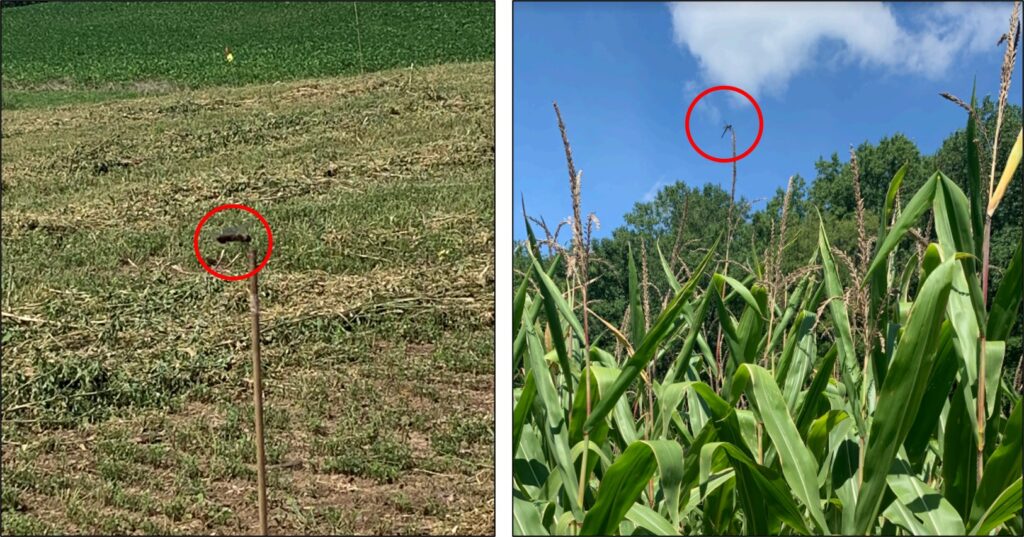
The next step is helping understand how on-farm retention ponds and lagoons can be managed to increase the health and habitat suitability for dragonflies and other beneficial aquatic taxa. Managing water sources on farms that can sustain dragonfly populations may increase the net ecosystem services provided by the water body, which will result in economic benefits from biological control, pollination and increased soil and water quality (Fig. 8). Assessing the vegetation within and around these water bodies will be an important step in understanding their suitability for odonates and other aquatic predators.
